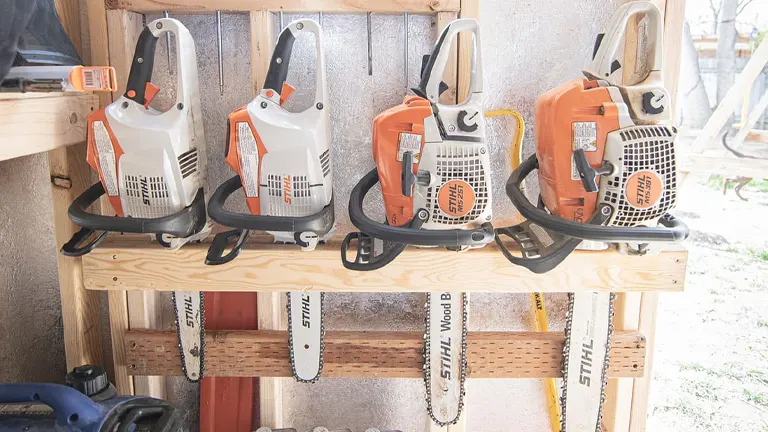Storing a chainsaw properly is crucial to prevent oil leaks. Many people struggle with this common issue.
A chainsaw is an essential tool for many tasks. But improper storage can lead to annoying oil leaks. Oil leaks not only waste valuable oil but also create a mess. Understanding the right storage techniques is key. This guide will help you keep your chainsaw in top condition.
You will learn effective methods to store your chainsaw. Say goodbye to oil leaks and hello to a cleaner, more efficient tool. Let’s dive into the best practices for storing your chainsaw to keep it leak-free.

Credit: forestry.com
Preparation For Storage
Proper storage of a chainsaw is crucial to prevent oil leaks and ensure longevity. Before you store your chainsaw, prepare it carefully. This preparation includes cleaning the chainsaw and inspecting it for damage. These steps help maintain the tool in good condition.
Clean The Chainsaw
Remove any debris or sawdust from the chainsaw. Use a brush or compressed air to clean hard-to-reach areas. Wipe down the exterior with a clean cloth. Pay special attention to the chain and bar. They should be free from any residue. A clean chainsaw is less likely to leak oil.
Inspect For Damage
Check the chainsaw for any visible damage. Look at the chain, bar, and other parts. Ensure there are no cracks or wear. Examine the oil reservoir and cap. They should be intact and secure. If you find any damage, repair it before storage. This step helps prevent leaks and ensures safety.
Emptying The Oil Tank
Emptying the oil tank is a crucial step in storing your chainsaw. It prevents oil leaks and keeps your tool in good condition. Follow these simple steps to ensure your chainsaw is stored without any mess.
Drain The Oil
First, place the chainsaw on a flat surface. Ensure it’s stable to avoid spills. Locate the oil tank cap on your chainsaw. Unscrew the cap carefully to avoid any sudden spills. Use a funnel or similar tool to help guide the oil out of the tank. Let the oil drain completely into a suitable container. This step ensures that no oil remains in the tank, which can leak out later.
Dispose Of Oil Properly
Never dispose of oil by pouring it down the drain. Used oil can be harmful to the environment. Instead, find a local recycling center or a place that accepts used oil. Many auto shops and recycling centers take used oil for proper disposal. Check your local regulations for more information on oil disposal. Proper disposal helps keep the environment clean and safe.
Removing The Chain And Bar
Properly storing your chainsaw is crucial to prevent oil leaks. One important step is removing the chain and bar. This ensures that your chainsaw is stored safely and remains in good condition. In this section, we will guide you through the process of detaching the chain and cleaning the bar.
Detach The Chain
First, make sure your chainsaw is turned off and unplugged. Wear protective gloves to avoid injuries. Locate the chain tensioner screw and loosen it. This will release the tension on the chain. Carefully slide the chain off the bar. Place the chain in a safe spot to avoid any damage.
Clean The Bar
With the chain removed, it’s time to clean the bar. Use a brush to remove any debris or sawdust. Pay special attention to the groove where the chain sits. Wipe the bar with a clean rag to remove any remaining dirt. Cleaning the bar ensures it stays in good shape and helps prevent oil leaks.
Lubricating The Components
Lubricating the components of your chainsaw is crucial for its longevity and performance. Proper lubrication ensures smooth operation and reduces wear and tear. By following these steps, you can store your chainsaw without worrying about oil leaks. Let’s dive into the essential components that need proper lubrication.
Apply Bar Oil
The chainsaw bar needs special oil to run smoothly. Start by cleaning the bar and chain. Remove any dirt or debris. Pour bar oil into the reservoir. Ensure it reaches the recommended level. This helps the chain move freely and reduces friction.
Grease The Bearings
Bearings play a vital role in your chainsaw’s operation. Locate the bearings in the guide bar and sprocket. Use a grease gun to apply grease. Make sure the grease reaches all parts of the bearings. This prevents them from drying out and causing damage.
Choosing A Storage Location
Proper storage of your chainsaw is crucial to prevent oil leaks. A good storage location can help maintain your chainsaw’s efficiency and prolong its lifespan. Let’s look at some important factors to consider when choosing a storage location.
Find A Dry Place
A dry place is essential for storing your chainsaw. Moisture can cause rust and damage. Ensure your storage area is free from any water sources.
Garages or sheds are often good options. If you don’t have a garage or shed, consider investing in a waterproof storage box. This can help keep the chainsaw dry and protected.
Avoid Sunlight
Direct sunlight can damage your chainsaw over time. It can cause the oil to thin and leak. Store your chainsaw in a shaded area to avoid this.
A cool, dark place is ideal. Heat can also warp plastic parts and degrade rubber components. Ensure your chosen location keeps the chainsaw away from sunlight and heat sources.
Positioning The Chainsaw Correctly
Storing a chainsaw correctly is vital to prevent oil leaks. Proper positioning helps maintain the chainsaw’s health and keeps your storage area clean. Let’s dive into the best practices for storing your chainsaw to avoid messy leaks.
Store Upright
Always store your chainsaw upright. This position keeps the oil where it should be. Place the chainsaw on a flat, stable surface. Ensure it stands securely. Use a stand or holder if needed.
Storing it upright helps prevent oil from seeping out. It also keeps the chainsaw in a ready-to-use position. This method is simple and effective.
Avoid Tilting
Avoid tilting the chainsaw when storing it. Tilting can cause oil to leak from the tank. This makes a mess and wastes oil. Always check the position before leaving it.
If the chainsaw must be moved, lift it carefully. Keep it upright during transport. This avoids any tilting that could cause leaks.
Regular Maintenance Checks
Regular maintenance checks are essential for storing your chainsaw without oil leaks. Performing these checks helps identify potential issues early. Follow these steps to keep your chainsaw in top condition.
Inspect Monthly
Each month, inspect your chainsaw carefully. Look at the chain, bar, and engine. Make sure nothing is worn or broken.
- Check the chain tension. A loose chain can cause leaks.
- Examine the bar for wear and tear.
- Inspect the engine for any visible damage.
Replace any damaged parts immediately. This helps prevent oil leaks and ensures safety.
Check For Leaks
Regularly check for oil leaks. Place a clean piece of cardboard under the chainsaw. Leave it overnight. In the morning, look for oil spots.
| Component | What to Check |
|---|---|
| Oil Tank | Look for cracks or loose caps. |
| Oil Lines | Ensure there are no splits or breaks. |
| Oil Pump | Check for proper functioning and no leaks. |
Fix any leaks you find. Tighten loose parts and replace broken components. This prevents oil from leaking during storage.

Credit: www.reddit.com
Using Protective Covers
Storing a chainsaw properly is crucial to prevent oil leaks. One of the most effective methods to achieve this is by using protective covers. Protective covers safeguard the chainsaw from dust and debris. They also help contain any oil that may seep out. Below, we explore two key protective measures: covering the bar and using a chainsaw case.
Cover The Bar
The bar and chain are the most exposed parts of a chainsaw. Covering them is vital. A bar cover, also known as a scabbard, fits over the bar and chain. This cover keeps the chain protected and prevents oil from dripping everywhere.
- Measure your chainsaw bar to find the right size cover.
- Install the cover by sliding it over the bar and chain.
- Check for a snug fit to ensure no oil leaks out.
Using a bar cover is a simple yet effective step. It keeps your workspace clean and reduces oil wastage.
Use A Chainsaw Case
A chainsaw case offers comprehensive protection. It covers the entire chainsaw, including the bar and chain. These cases are usually made of durable plastic or metal.
| Features | Benefits |
|---|---|
| Durability | Protects the chainsaw from physical damage |
| Oil Containment | Prevents oil from leaking onto surfaces |
| Portability | Makes it easier to transport the chainsaw |
To use a chainsaw case, follow these steps:
- Clean the chainsaw to remove any excess oil and debris.
- Place the chainsaw inside the case, ensuring it fits securely.
- Close the case and latch it shut.
Using a chainsaw case is an excellent way to store your tool. It keeps it safe, clean, and leak-free.

Credit: www.reddit.com
Frequently Asked Questions
How Do I Prevent Chainsaw Oil Leakage?
To prevent chainsaw oil leakage, store it in an upright position. Ensure the oil cap is tightly sealed. Regularly clean the oil reservoir area to remove debris.
Why Does My Chainsaw Leak Oil When Stored?
Chainsaws may leak oil when stored due to a loose oil cap or residual oil in the reservoir. Proper storage can minimize leaks.
Can I Store My Chainsaw With Oil Inside?
It’s best to drain the oil before storing the chainsaw. This prevents leaks and maintains the chainsaw’s condition for future use.
What Is The Best Way To Store A Chainsaw?
The best way to store a chainsaw is in an upright position. Ensure it’s clean and dry, with the oil cap securely tightened.
Conclusion
Storing your chainsaw properly prevents oil leaks and prolongs its life. Always clean it after use. Check for any damage regularly. Store it in a dry place. Use a case if possible. Empty the oil reservoir before storage. Keep it well-maintained.
Follow these tips to avoid oil leaks. Your chainsaw will stay in good condition. Happy sawing!
